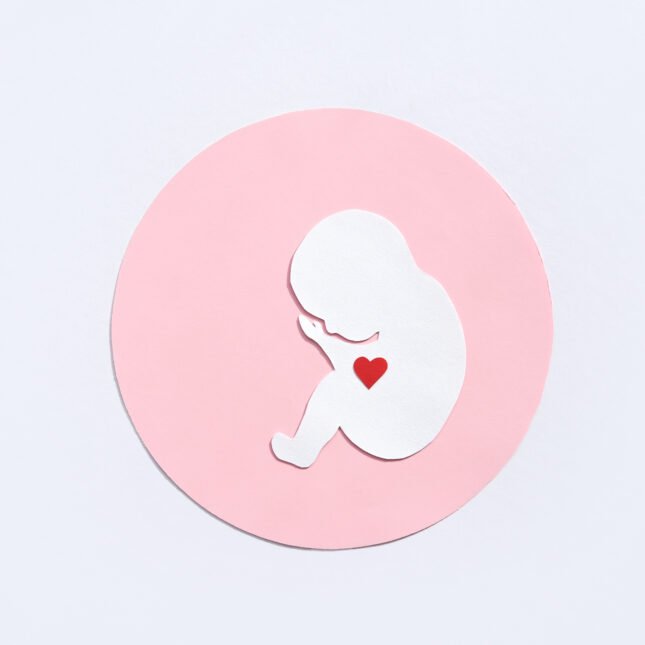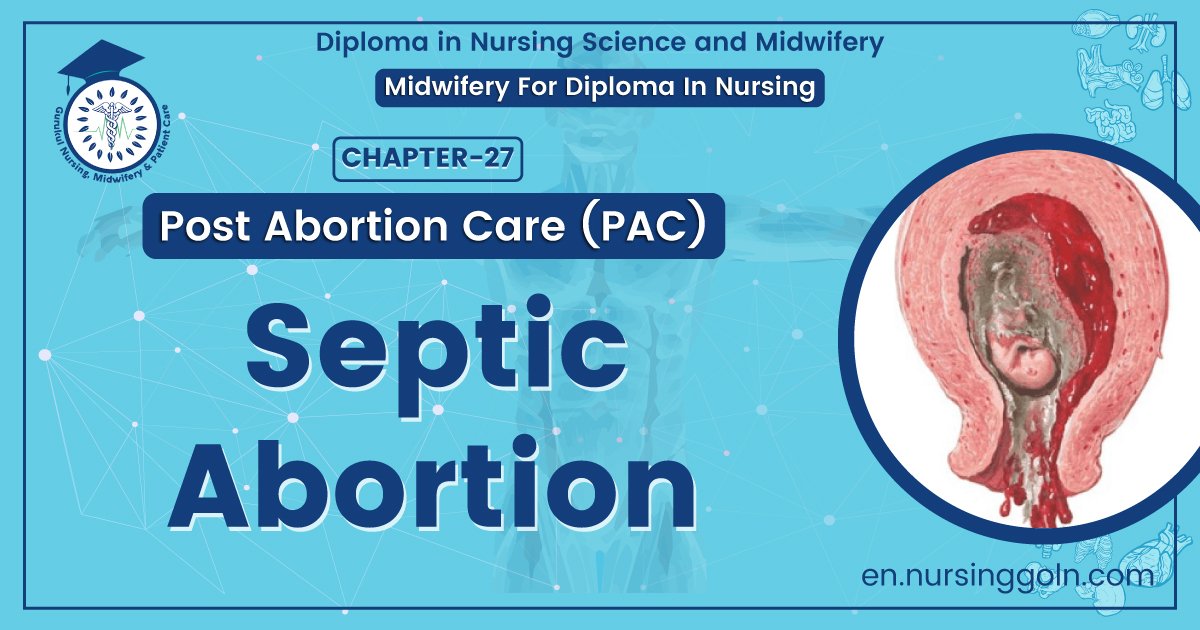Septic abortion – This course is designed to understand the care of pregnant women and newborn: antenatal, intra-natal and postnatal; breast feeding, family planning, newborn care and ethical issues, The aim of the course is to acquire knowledge and develop competencies regarding midwifery, complicated labour and newborn care including family planning.
Septic abortion
Definition of Septic Abortion:
Any abortion associated with clinical evidence of infection of the uterus and its contents is called septic abortion.
Or
Septic abortion is an abortion associated with a uterine infection. The infection can occur during or just before or after an abortion.
Or
Any abortion associated with clinical evidence of infection of the uterus and its contents, is called septic abortion.
Although criteria vary, abortion is usually considered septic when there are:
- rise of temperature of at least 100.4°F (38°C) for 24 hours or more;
- offensive or purulent vaginal discharge and
- other evidences of pelvic infection such as lower abdominal pain and tenderness

Causes/Causative Organisms of Septic Abortion
| A. Anaerobic: |
|
| B. Aerobic: |
|
Management of Septic Abortion:
A. History:
There is usually a history of induction of abortion (criminal abortion) un-hygienically by untrained person or H/O spontaneous abortion (missed or incomplete).
B. Clinical features:
a) Symptoms:
1. Fever associated with chills & rigor or subnormal temp, (feature of ominous endotoxic shock)
2. Continuous, severe lower abdominal pain.
3. Foul smelling vaginal discharge- purulent, sometimes frothy discharge in local endometritis; scanty lochial discharge in septicaemia.
4. General systemic upset anorexia, vomiting, joint pain, headache, flushed appearance, sweating, dehydration etc.
5. Bleeding due to coagulation failure- if Cl. Welchii infection.
b) Signs:
1. The pt. may look toxic & pale
2. There may be rise of temperature, tachycardia, hurried respiration and hypotention, specially if it is associated with excessive haemorrhage or septic shock.
3. Abdomen may show tenderness, rigidity, distention or muscle guard; Bowel sound may not be present- paralytic
4. If there is hemolysis by Cl. Welchii infection-
- Severe anaemia
- Post wine colored urine
- Jaundice. 5. P/V examination: may shows-
- Foul smelling discharge which may be blood stained.
- Injury to the cervix or vagina & foreign body inside the genital tract,
- The product may or may not be hanging through the open cervix
- The fornices may be tender and full; Some cases, a cystic swilling is found in the pouch of Douglus due to accumulated pus. 6. Uterus is bulky, soft and tender. Uterine size may correspond to the gestational age or smaller or could not be determined, as it is not clearly defined due to pelvic adhesions and abscess

C. Investigations:
1. High vaginal swab or cervical swab for C/S & gram staining: may show the presence of causative organism
2. Blood:
- TC, DC-Neutrophilic leukocytosis
- Hb% – may be low
- ABO & Rh typing
- C/S: Both aerobic & anaerobic media
3. Urine: R/M/E & C/S
4. USG: of abdomen & pelvic to see any retained product of conception (3)
5. If complicated with renal failure-
- Blood úrea levél
- S. electrolytes: HCO3 level
6. Coagulation profile may show low fibrinogen
7.8X-ray abdomen to see peritonitis or pneumoperitoneum
D. Treatment of septic abortion
1. Hospitalization and isolation
2. If infection is localized to the uterus
- (a) Parenteral antibiotics
- Inj. Ampicillin 500 mg 6 hourly
- Inj. Metronidazole 300 mg 8 hourly
- Inj. Gentamicin 2-5 mg/kg/day 8 hourly
(b) Blood transfusion
(c) Analgesics if required
(d) Evacuation and curettage of uterus should be performed within 12-24 hours of initiation of antibiotics, if it is incomplete abortion. In case of excessive bleeding, evacuation and curettage should be done immediately though there is a chance of spread of infection.
3 . Treatment of endotoxic shock:
(a) IV fluid and antibiotics
- Penicillin G 1-2 mega Units IM
- Metronidazole
- Gentamicing
(b) Correction of a anemia, adequate nutrition
(c) Corticosteroids: Hydrocortisone 300-500 hourly IV then gradually taper the dose
4. If these is pelvic peritonitis and pelvic abscess, in addition to the4 above mentioned management followings are also to be given –
(a) Patient is to be kept nothing by mouth
(b) Parenteral nutrition by IV fluid
(c) Pelvic abscess: Colpotomy done in OT to drain the pus
5. If there is generalized peritonitis with paralytic ileus, the management will be as follows –
(a) Nothing by mouth, nasogastric suction
(b) Parenteral nutrition by IV fluid
(c) Parenteral antibiotics –
- Inj. Ampicillin 500 mg 6 hourly
- Inj. Metronidazole 300 mg 8 hourly
- Inj. Gentamicin 80 mg 8 hourly
(d) Blood transfusion is to be given if necessary
(e) Assessment of general condition of the patient
6. Treatment of anuria or oliguria:
(a) Fluid restriction: 500 mg + previous day output in 24 hours
(b) High carbohydrate, low protein diet!
(c) Restricted intake of Na+ & K+
(d) If no evidence of improved urinary output or if blood urea rises> 85 mmol/L after 5-6 days of above treatment-dialysis is indicated
7. If patient is not responding to vigorous treatment, laparotomy is indicated after 48 hours after laparotomy
(a) Pus is to be drained or any other mass is to be removed
(b) Whole of the gut is to be inspected thoroughly for any injury
(c) Hysterectomy is the operation of choice for smooth recovery as infected uterus has been removed.

Complication of Septic Abortion:
| A. Immediate complication: |
|
| B. Late complication: |
|
Prevention of Septic Abortion:
In order to prevent the incidence of septic abortion, the following steps are to be taken:
1. Creating the awareness about its consequences & complications, which leads to death.
2. Female education mandatory
3. Discourage early marriage & early conception.
4. Remove superstition.
5. Prevention of prenatal sex determination.
6. Premarital counseling for prevention of unplanned & unwanted pregnancies
7. Availability & accessibility of family planning methods including menstrual regulation.
8. Adequate family planning advises.
9. Change of social custom & attitude towards the girl child.
10. Training of residents.
11. Relaxation of abortion law.

Problem Based Question
Q. A 26 years old woman came with the complaints of amenorrhoea for three months and history of inserting foreign body inside the uterus 4 days back. Examination revealed temp. 1000F, abdomen tender and distended, uterus is about 12 weeks size, Os open.
a) What is your diagnosis?
b) Mention 5 important complications of the patient
c) How can you prevent this condition?
Answer:
- Diagnosis: Septic abortion
- Complications + prevention: Please see above
Read More…
